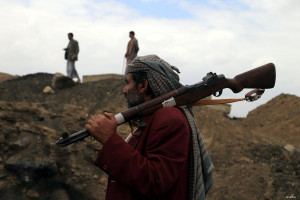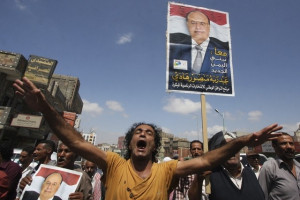
And if Yemen somewhat managed to remain in political and institutional limbo for the longest time, held in suspension by meddling foreign powers, the return onto the scene of one formerly resigned President Abdo Rabbo Mansour Hadi exploded this delicate house of cards, laying bare regional tectonic plates.
While mainstream media have mainly focused on the sensational of Yemen – the western labelled politico-sectarian tug of war in between one Shia Houthi faction and one Sunni amorphous opposition group, the public has once again been left in the dark. There is definitely more to Yemen’s crisis than meets the eye.
In all truth, what is happening in Yemen will redefine the Middle East in more ways than Syria and Iraq will. Where Iraq and Syria have become the first victims of fundamentalism, the frontlines of neo-Wahhabism, Yemen will be what breaks the camel’s back – in this case Saudi Arabia.
Yemen’s political crisis needs to be understood from both a regional and global perspective. In this one country of the Arabian Peninsula three superpowers have come to collide, clash and overlap, in such a way that no matter the outcome, the Middle East and the world will remain forever change.
Whether Yemen knows it or not, its 2011 uprising set in motion a series of events which precipitated the rise and fall of the very powers which so far held the region in balance — the United States, Saudi Arabia and Iran.
By rising against the establishment, Yemenis upsetted an intricate balance of powers,spinning conflicting ideologies, geopolitics and ambitions out of their axis, thus forcing nations and factions to rethink and re-address their position within that web.
However poor and unruly, however under-developed and politically unpredictable Yemen remains a geostrategic jewel of such crucial importance that three world superpowers stand now willing to wage war against each other to claim control over its land.
Where world powers have managed to respect a certain status quo over both Syria and Iraq for fear of a mighty military unravelling, sticking instead to the usual rules of engagement, Yemen has been played to a different tune. That alone should tell you that this stretch of land holds the key to the kingdom – control over the Middle East.
So what in the world is really going on? How does Yemen political crisis play into this great game powers play?
Let us first look back at recent events and see how they actually fit within the greater picture. When it comes to Yemen, one rule applies – nothing is ever just as it seems.
Shadow games
Right up until last September – 2014 – one main faction benefitted from Yemen 2011 uprising: Al Islah. A Sunni radical faction which acts an umbrella for the Muslim Brotherhood and several tribal and Salafi sub-groups, Al Islah was in many ways the political extension of Al Ahmar family, Yemen’s most powerful and prominent tribe. The kings of Yemen as many called them, ruled all mighty over the Republic via their rich Saudi patrons.
Raised to act a counter-power to former President Ali Abdullah Saleh, Al Ahmars rode Yemen’s revolutionary wave to become the uncontested ruler of southern Arabia – only their claim was challenged by their main political and religious nemesis: the Houthis.
Just as Al Islah thought itself the grand winner of Yemen, events in Egypt and Saudi Arabia’ sudden dislike of the Muslim Brotherhood – which faction was sponsored and propped up by Riyadh to serve its interests across the ME, until it became too powerful for comfort – changed everything, making it possible for the Houthis to stage a comeback.
Yes a comeback!
If the Houthis have been described as a nebulous rebel militia lost in the wilderness of Yemen northern highlands, let us all remember that this so-called “Shia rebels” as experts have chosen to label them, happen to be rooted in Yemen’s history. Their arrival onto the political scene therefore qualifies more as a return than a surprising surge.
Let us remember that prior to becoming a republic, Yemen lived as a Zaidi kingdom.
The Houthis are the heir of this tradition. And though their political ambitions are indeed democratic, their history is tied up to this lineage. They did not simply manifest out of thin air.
But let us go back to September 2014, when strong of the support of hundreds of thousands of Yemenis – both Zaidis and Sunnis – the Houthis, under the leadership of Abdel-Malek Al Houthi breached Al Ahmar tribal siege over Sana’a, de facto putting an end to Al Islah’s hold over Yemen’s politics.
Caught in this battle of will was President Hadi. A puppet politician whose loyalty has oscillated in between Riyadh and Washington, depending on the currency rate.
Before the might of the Houthis, before the sheer weight of both political pressure and popular will, Hadi simply caved in, choosing to resign rather than be driven out by his own inadequacy.
Four months after the Houthis rolled into Sana’a, chasing out the Muslim Brotherhood from its seats, President Hadi presented his resignation, arguing irreconcilable differences.
Within days, Hadi and his former government were put under house arrest. Slowly and ever carefully the Houthis worked to heal Yemen’s political and tribal divide.
But if Hadi was keen to capitulate, Saudi Arabia was not ready to throw in the towel just yet.
Came hail or high water, Riyadh could not after all allow yet another Arab capital to fall to its foe – Iran. Without giving in to of conspiracy theories, there is no denying that the Houthis and Iran share close bonds of friendship, notwithstanding the fact that they both fall within the same ideological pool.
Since Riyadh’s initial play miserably failed – the Houthis and Al Islah were set up to destroy each other, leaving Al Saud’s a free hand in the impoverished nation – the kingdom was left with no other choice but to back peddle and revert to supporting Al Islah, even if by doing so it stands to reignite the fire of the Muslim Brotherhood and ultimately endanger the region’s political balance. Against all odds both the UAE and Egypt are backing Al Saud’s move.
A new dimension of complicated

Within days of such a flamboyant comeback, all western capitals and GCC countries announced they were withdrawing their embassies. Sana’a was diplomatically outlawed. From that moment all bets were off.
The Houthis became the Shia enemy and Hadi suddenly decided that his resignation was in fact invalid. The formally resigned, now self-reinstated former president of Yemen declared Aden the new temporary capital of Yemen, prompting diplomats to relocate in great pomp.
Aden was giving a new lease of life. Two decades after it lost its capital status, Aden is back on the map, revived to act the new frontline against Iran’s gravitational pull.
But here is where Riyadh’s plan stick – four years into its revolutionary transition Yemen is a very different political beast altogether. Al Saud rules no longer undisputed over the Peninsula. Yemenis and factions in Yemen have come to learn that there is a reality beyond that which has been weaved by Al Saud royals.
Yemen does have a choice. And there lies a reality Saudi Arabia has failed to grasp.
Yemen is no longer a Saudi satellite. A few months away from the suffocating shadow of Al Saud was enough to inspire a new Yemen, an independent Yemen where religious fundamentalism no longer needs to be a reality Yemenis have to put up with, where Riyadh does not dictate their future.
So here we are with the Houthis in the north and Hadi in the south.
A President without a presidency, Hadi is also a politician without a faction. As battlelines have been drawn the GPC – General People’s Congress – gathered around its founder, former President Saleh, joining its fate to that of the Houthis, its new ally against Saudi Arabia.
In Aden, Hadi is leading an amorphous political coalition composed of Al Islah and other political and tribal factions.
This set up, Riyadh hopes, will lead to the disintegration of the Houthis and the political death of former President Saleh.
Only, not everyone wants the Houthis and Saleh to go away just yet.
If Washington is not comfortable with allowing the Houthis to rule over Yemen, it also understands that the Houthis and Saleh could act a tactical buffer to Al Saud’ spiralling and self-destructing theocratic rule in the region.
For all its petrodollars, the kingdom of Saudi Arabia is unravelling. Plagued by a cancer it created to support its expansion – Islamic terrorism, challenged from within by an increasingly unhappy population, Saudi Arabia has found itself cornered by Iran. From the Levant to the Gulf, Iran’ shadow has blotted Al Saud’s sun.
Washington understands that its longstanding ally could soon turn into its biggest political liability and so, it is making provisions for the future, putting its hands in both pots.
The situation is this: Iran wants to weave Saudi Arabia out of the Middle East and to do so it needs Yemen, or rather it needs north Yemen. With its majority Zaidi population, north Yemen stands a natural ally of Iran against Wahhabi Saudi Arabia. And though the whole of Yemen would represent an incredible asset, Tehran understands that it will have some difficulty exercising its influence over a predominantly Sunni south Yemen.
The US wants first and foremost to secure both its military and financial interests in Yemen, while not engaging into a lengthy conflict which could see arise new players and disrupt an already complex political dance. For the sake of its recent diplomatic overtures toward Iran and in view of brokering a sustainable alliance with one of the region’ superpower Washington will likely push for a truce, calling for either the partition of Yemen or the federalization of Yemen with a north-south set up.
The Houthis would rule over north Yemen, withdrawing being 1990 borders and Al Islah would rise the new ruler of south Yemen under Saudi patronage.
The only real loser here is Saudi Arabia.
Al Sauds want both the Houthis and Saleh gone.
And though it would appear the international community, through the UNSC has played the game, threatening to sue and asset freeze, such words are but threats aimed to level the negotiating field.
Ultimately, Washington wants to make a deal.
Whichever way this crisis will play out, whether or not war indeed breaks out, Riyadh will still lose. The kingdom will not get Yemen back under its thumb.
By playing the terror card and envisioning it can manipulate without ever suffering any repercussions, Saudi Arabia will crumble its empire.
Catherine Shakdam is the Associate Director of the Beirut Center for Middle Eastern Studies and a political analyst specializing in radical movements, exclusively for the online magazine “New Eastern Outlook”.
